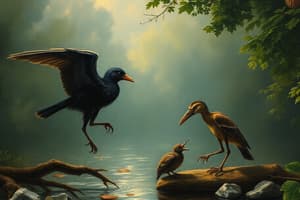Podcast
Questions and Answers
Which term refers to a community where organisms constantly interact with a significant impact on the ecosystem?
Which term refers to a community where organisms constantly interact with a significant impact on the ecosystem?
- Population
- Community (correct)
- Ecosystem
- Species
What type of interaction occurs when two organisms attempt to use the same ecological resource at the same time?
What type of interaction occurs when two organisms attempt to use the same ecological resource at the same time?
- Commensalism
- Symbiosis
- Predation
- Competition (correct)
What is considered a resource that organisms might compete for?
What is considered a resource that organisms might compete for?
- Genetics
- Temperature
- Predators
- Sunlight (correct)
In a predation interaction, what role does the organism that is captured and consumed play?
In a predation interaction, what role does the organism that is captured and consumed play?
Which of the following describes natural selection's effect on predators over time?
Which of the following describes natural selection's effect on predators over time?
What is the outcome when organisms compete for resources?
What is the outcome when organisms compete for resources?
What adaptation might a predator develop to improve its chances of capturing prey?
What adaptation might a predator develop to improve its chances of capturing prey?
How do adaptations help prey organisms in the context of predation?
How do adaptations help prey organisms in the context of predation?
What role do herbivores play in the ecosystem?
What role do herbivores play in the ecosystem?
What is the main benefit of mimicry for prey species?
What is the main benefit of mimicry for prey species?
Which of the following is an example of mutualism?
Which of the following is an example of mutualism?
What adaptation might plants develop to deter herbivores?
What adaptation might plants develop to deter herbivores?
Which statement about parasites is true?
Which statement about parasites is true?
What type of relationship is exemplified by the interaction of birds eating ticks from hippos?
What type of relationship is exemplified by the interaction of birds eating ticks from hippos?
What do termites provide to the bacteria living in their gut?
What do termites provide to the bacteria living in their gut?
How do some prey species avoid detection by predators?
How do some prey species avoid detection by predators?
Which of the following is NOT a method by which plants defend themselves?
Which of the following is NOT a method by which plants defend themselves?
In the mutualistic relationship between ants and acacia shrubs, what do the ants receive from the plant?
In the mutualistic relationship between ants and acacia shrubs, what do the ants receive from the plant?
Which of the following describes commensalism?
Which of the following describes commensalism?
What is an example of an ectoparasite?
What is an example of an ectoparasite?
What is the main feature of parasitism?
What is the main feature of parasitism?
What do barnacles obtain from attaching to whales?
What do barnacles obtain from attaching to whales?
What distinguishes endoparasites from other types of parasites?
What distinguishes endoparasites from other types of parasites?
What is the role of the triggerfish in the commensal relationship with smaller fish?
What is the role of the triggerfish in the commensal relationship with smaller fish?
Flashcards
What is a community?
What is a community?
All the living organisms found in a specific area.
How do organisms within a community interact?
How do organisms within a community interact?
Organisms interact with each other constantly, greatly influencing the ecosystem.
What is competition?
What is competition?
When organisms of the same or different species compete for the same limited resource at the same time and location.
What is a resource in ecological terms?
What is a resource in ecological terms?
Signup and view all the flashcards
What is predation?
What is predation?
Signup and view all the flashcards
What is a predator?
What is a predator?
Signup and view all the flashcards
What is prey?
What is prey?
Signup and view all the flashcards
How do adaptations benefit organisms?
How do adaptations benefit organisms?
Signup and view all the flashcards
Commensalism
Commensalism
Signup and view all the flashcards
Parasitism
Parasitism
Signup and view all the flashcards
Endoparasites
Endoparasites
Signup and view all the flashcards
Ectoparasites
Ectoparasites
Signup and view all the flashcards
Mutualism
Mutualism
Signup and view all the flashcards
Host
Host
Signup and view all the flashcards
Symbiosis
Symbiosis
Signup and view all the flashcards
Mimicry
Mimicry
Signup and view all the flashcards
Batesian Mimicry
Batesian Mimicry
Signup and view all the flashcards
Herbivores
Herbivores
Signup and view all the flashcards
Mutualism between Flowers and Insects
Mutualism between Flowers and Insects
Signup and view all the flashcards
Plant Adaptations
Plant Adaptations
Signup and view all the flashcards
Study Notes
Species Interactions
- A community is all the living organisms in a particular area.
- Organisms in communities interact constantly, impacting the ecosystem significantly.
- Interactions can be categorized as: Competition, Predation, Symbiosis (includes Mutualism, Commensalism, Parasitism).
Competition
- Competition occurs when organisms (same or different species) strive to utilize the same resources in the same place and time.
- Resources include food, water, light, nesting sites, or room to grow.
- Competition often results in a winner and a loser, with the winner thriving and the loser failing to thrive or survive.
Predation
-
Predation is an interaction where one organism captures and consumes another.
-
The organism that kills and eats is the predator.
-
The organism that gets consumed is the prey.
-
Predation is crucial in shaping communities and regulating population sizes.
-
Predators are more efficient due to adaptations like keen senses, sharp teeth, or predatory strategies (favored by natural selection).
-
Prey may evolve adaptations like speed to escape, camouflage to avoid detection, or warning colours to deter predation.
-
Mimicry is a form of deception. A harmless species mimicking a harmful/distasteful species.
### Symbiotic Relationships
- Symbiosis is a close and permanent relationship between different species. There are three main types:
- Mutualism: Both species benefit. (e.g., Flowers and insects, ants and acacia trees, termites and gut bacteria)
- Commensalism: One species benefits, the other is neither harmed nor helped. (e.g., Triggerfish and small fish, barnacles and whales)
- Parasitism: One species benefits (parasite), the other is harmed (host). (e.g., ticks, fleas, some bacteria and tapeworms)
- Parasites can be internal (endoparasites - living inside their host) or external (ectoparasites - living on the surface of their host).
Studying That Suits You
Use AI to generate personalized quizzes and flashcards to suit your learning preferences.




